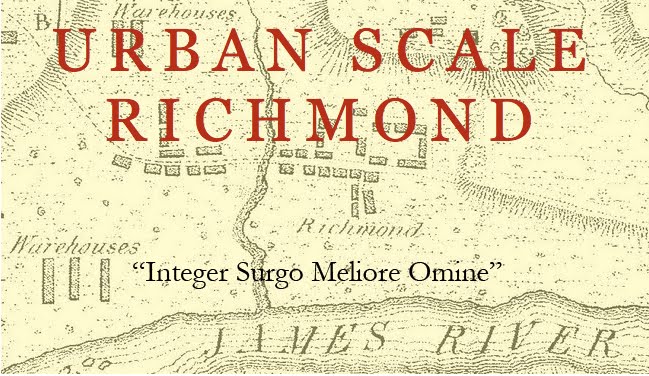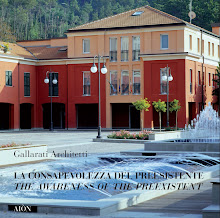If you were alive in the Paris of Louis XIV, the impression of these new boulevards and avenues would be of a tremendous formalizing of nature, rather than of urbanization. The chief device, the parallel rows of trees was a fairly easy way to achieve stunning monumental effects and perspectives with little actual material and labor. These abstract diagrammatic schemes signified little beside the kings' ability to make a rural landscape orderly --something he clearly relished. However, when they finally were developed with buildings decades later, the boulevards and avenues of Louis XIV would become templates for the best of the Second Empire's new street typologies, and they remain models for excellent street sections into our time.
The City in Mind, James Howard Kunstler
Thanks to The Gates of Memphis for the quote.
 |
| Monument Avenue, Richmond, mid-20th c. |
 |
| Le Notre's Garden at the Tuileries, Paris, 17th c. |
The use of the tree as an urban-scale street amenity is a relatively modern development. Trees were restricted to gardens among the narrow streets of most cities. By the seventeenth and eighteenth centuries, trees were organized into bosquets and rides intended to delineate the vistas and axial routes that converged on Baroque palaces. The primary purpose of trees in the baroque landscape was to underline and sculpt the lineaments of site design. A secondary purpose was served by providing shade for those viewing or passing through the landscape.
As the European city expanded, it enveloped and expropriated the ornamental parks and hunting grounds that were originally set apart for royal use. Planners of eighteenth-century continental and British cities extended the language of Baroque garden design to the entire urban form, underlining important routes, axes, and nodes with trees planted in neat patterns and rows. As boulevards and promenades appeared in the late eighteenth century, individual trees were subsumed within a grand overall scheme and planted in such a way that their form, color, and size assisted in directing the eye and setting the scene. Massing of trees of one species or reiteration or alternating patterns among several types helped clarify the city’s urban order.
Richmond, like most American cities, was slow to enable any collective provision of shade for pedestrians. Such as there was along the streets was provided by the overhanging boughs extending from some of the city’s large gardens. Richmond’s chronicler Samuel Mordecai remembers a house on Main Street near the foot of Church Hill which was surrounded by a walled garden and flanked by a row of elm trees that were “like an oasis in a desert, and furnished a refreshing shade to the pedestrian on a hot summer day- of which I can speak from experience.”
 |
| B. H. Latrobe, Lombardy Poplars on Pennsylvania Avenue, Washington, before 1814. |
Americans began after the Revolution to place trees in the growing cities of the eastern seaboard. Thomas Jefferson likely saw trees in a supporting role in the design of the new Capitol district atop Shockoe Hill. One of the earliest references to street trees in Richmond is the planting of Jefferson’s much-favored Lombardy Poplars along Main Street at the foot of Shockoe Hill in the last years of the eighteenth century. Widely propagated in Northern Europe for their quick growth, elegant shape, and Italian manners, Lombardy Poplars were selected by Jefferson to line Pennsylvania Avenue during his occupancy of the White House. According to chronicler Samuel Mordecai, the poplars in Richmond grew to a great height until they were attacked by a variety of caterpillar. Although still widely used for urban ornamental plantings, Lombary Poplars rarely live more than fifteen years. Evidence suggests that Richmond joined other eighteenth-century American cities in adding trees along other selected streets for urban emphasis, shade, and utility. Richmond streets and alleys received tree names related to the kind of trees that were planted along their edges.
 |
| Regular lines of trees fill Godefroy's Capitol Square from Mijacah Bates' map of 1835. |
The City’s Public Square, containing the Capitol surrounded by an irregular and undeveloped terrain, was improved under the direction of French-born engineer Maximilian Godefroy between 1816 and 1820. He transformed the ravines flanking the Capitol into two tree-lined pedestrian boulevards each containing a cascade organized by a series of marble basins. When the saplings were damaged by cattle in 1818, the city responded by providing new plantings of exotic and native varieties. When the Capitol Square was re-landscaped in the early 1850s, naturalistic plantings of native species were preferred by landscape architect John Notman to exotics. Capitol Square, as seen in the drawing below, was now surrounded by sidewalk trees, each side planted with a different species [Potterfield 62]. The square containing City Hall was landscaped at the same time and contemporary images attest that it was a cool retreat along Broad Street, even as the trees nearly concealed the structure’s columned portico. Trees were added along some residential streets as well.
 |
| Trees are seen along residential streets in Court End at the end of the Civil War. |
 |
| Evocative illustration of the shaded front of Mills' City Hall from Dabney, The Last Review, 1934 |
 |
| Civil War-era photograph of City Hall from Capitol Square, 1865 showing trees planted in the previous decade and housed in protective wooden surrounds |
 |
| Detail from the 1850s showing Ninth Street on the west side of Capitol Square [Reps] |
By the middle of the nineteenth century, the city government responded to the city's increasing density by recognizing the need for a series of public recreational parks to supplement the Public Square, now known as Capitol Square. Acquired in the 1850s, these tracts remained unplanted fields and hillsides until after the end of the Civil War. After the war, the city began to lay out paths and place trees in these parks, which included Monroe Park, Libby Hill and Gamble’s Hill, and others established after the war, including Chimborazo, Taylor’s Hill, Jefferson Park, and Riverside Park. Monroe Park was laid out by Wilfred Cutshaw in a series of criss-crossing paths that were lined with trees. As in the city at large, each path was lined with consistent allees of matching trees. A catalog of 26 tree varieties in 1904 shows the number and types of trees used in the park, which included sugar maples, silver maples, several varieties of oaks, elms, and lindens.
 |
| Col. Wilfred E. Cutshaw |
As Tyler Potterfield has shown, Wilfred Cutshaw, city engineer from 1873 to 1907, was responsible for the transformation of Richmond from a treeless pedestrian desert into a well-funded follower of the national “City Beautiful” movement. He established a program for the “proper selection, spacing, and planting” of trees throughout the city. Over fifty thousand trees were raised and set out by the city between 1890 and 1904 with the intention of establishing a tree canopy over most of the city’s walkways. An amenity that was formerly restricted to special precincts, gardens, and urban parks was extended to the entire city at public expense. Even so, the strictly commercial sections of the city were never lined with trees: visibility and ease of access were more important to the city's stores and shops. The rows of brick commercial buildings fronting on narrow pavements or boardwalks and shaded by continuous lines of awnings did not require any added shade or emphasis.
At its peak in the first half of the twentieth century, Richmond took its street trees very seriously. The city employed an arborist and raised hundreds of trees in an large nursery around the reservoir in Byrd Park, later moved to Bryan Park. Each residential street in the city was planted in a tree species that gave it a distinct character. Favorite trees were the American elm, the sugar maple, and the silver maple. Other varieties included the linden, the tulip poplar, the sycamore, and several types of fast-growing oaks. Boulevard was lined with linden trees, likely in conscious emulation of the famous Unter den Linden strasse in Berlin. Monument Avenue was lined with sugar maple trees. Important sections of many streets, including Floyd Avenue, Clay Street, and Franklin Street, were lined with tall and graceful elms.
 |
| Surviving section of alternating American elm and tulip poplar trees in the 3500 block of Seminary Avenue, Ginter Park |
 |
| The patterned trunks of sycamore trees lining a side street in Laburnum Park. |
Richmond abandoned its tree replacement program in the 1970s. Trees were added to major new streets and along thoroughfares only as special projects funded by the city procurement process. Trees are, however, pruned and removed as required by a team of arborists contracted by the city. Renewed interest in tree replacement has led, in recent years, to a piecemeal replacement program, often led by volunteer or neighborhood advocates. The Richmond Tree Stewards program was organized as a citizen involvement program by one of the city’s arborists. It undertakes training and certification of citizen volunteers, who assist in pruning, replanting, and watering trees.
The city’s current arborial program is informed by the contemporary idea of the “Urban Forest,” which traduces the classical and neo-Baroque intentions of the city’s nineteenth- and twentieth-century planners. Instead of using trees to support, by their placement and form, the city‘s urban fabric, tree management policy is governed by concerns for tree health, avoidance of electrical wires, and protection of sidewalk pavements. For example, planting in single species is strongly discouraged, since it is thought that disease spreads more readily among trees of the same type whose roots are interlaced. As a result, when new trees are planted, specimens of four or five arboist-recommended tree varieties are now placed without pattern along most of the city's streets.
 |
| Comparing the form: mature (and soon to be replaced) American elm to left and young Zelkova replacements at center and right on the 3700 block of Brook Road |
Today, however, the rate of planting is not keeping up with tree mortality and the existing stock of trees is rapidly diminishing. Many stately trees, such as maples, once prized for their spreading crowns and autumn color are no longer considered appropriate for this climate. Gum trees and ginkos are among the most commonly required where large canopies are permitted. Zelkova trees have been widely used to replace American elms after elms were decimated by disease, although improved strains of the arching, lacy American elm are now available. Zelkova have proved to be radically different in form, habit, and longevity. Trees of smaller stature and habits, including such widely differing types as redbud and crepe myrtle, are placed under electric wires and in other location where height is seen as a problem. Trees are no longer planted at sufficiently close intervals to result in a continuous canopy. The lack of consistency of tree scale and form along city streets has meant a gradual degradation of the coherence of Richmond's urban form. This means not only a loss of shade, but of the distinctive color and character of individual streets and neighborhoods.











No comments:
Post a Comment